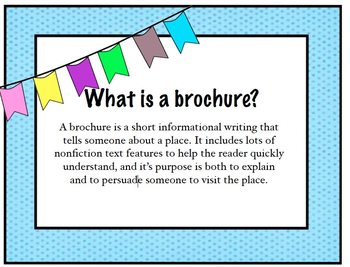- Zip
Description
A great unit project to combine non-fiction text features, non-fiction reading, and geography. It also includes a map skills activity as well! There are graphic note-taking organizers for City, Country, State or general place to meet the goals of your geography learning. The examples include a city and a National Park, and the files also support country reports or even state reports.
This file includes:
1. Presentation file--Introduces the brochure and features informative posters about all nonfiction text features with examples and sample paragraphs written using the Step Up to Writing model. These are full color and could be printed for bulletin boards and/or projected for lesson presentation.
2. Graphic Organizer “My Place.” Leads students toward interesting and thoughtful research about their places.
3. Brochure Example--A completely worked up example of a trifold brochure
4. Notetaking Page #2--different versions for city, state, country, or place. An additional note-taking graphic organizer.
5. Working draft papers (2)--Again based on Step Up model.
6. Brochure rubric.




